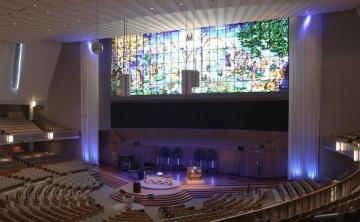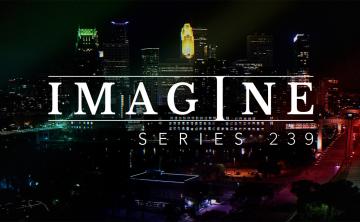The Sadowski Custom Rodgers Theater Organ

We bring you good news recently posted to Facebook about a historical Rodgers theater organ, known as the “Sadowski Custom Rodgers,” which has found a new home to be completely restored. This organ is regarded as one of the finest analog organs ever built.
 We reprint the Facebook story here with permission from the new owner of the organ, Joseph Egon Pechenik:
We reprint the Facebook story here with permission from the new owner of the organ, Joseph Egon Pechenik:
It is my joy to introduce to all of you my newest addition to my Rodgers Organ Company collection, and my newest 'friend': The Rodgers Sadowski 260 Special. This fine instrument is built from the rubric of Bob Power's Rodgers 260, yet with more ranks and expanded stop rail. Two Tibias, three 32's (one being a reed!) and a great variety of mutations and strings make this organ very unique. This instrument also utilizes some 40 amplifiers (two channels each), with multiple 30'' inch subwoofers and many custom-built JBL horns.
 The console itself is styled after a Wurlitzer 260 and hand-painted in the Rodgers factory to mimic Slavic folk art. The "Sadowski Special," as it’s called, is debatably the largest analog organ the Rodgers Organ Company ever produced, I have heard that it possessed the same number of, if not more, oscillator boards contained in the famous 5-manual Rodgers Carnegie Hall organ. The Sadowski Special is probably the largest analog theatre organ ever produced. It is to my dismay that most of the instrument is no longer functioning, it will require years of work to restore it to its former glory, and I excitedly begin the project. Pray for me!
The console itself is styled after a Wurlitzer 260 and hand-painted in the Rodgers factory to mimic Slavic folk art. The "Sadowski Special," as it’s called, is debatably the largest analog organ the Rodgers Organ Company ever produced, I have heard that it possessed the same number of, if not more, oscillator boards contained in the famous 5-manual Rodgers Carnegie Hall organ. The Sadowski Special is probably the largest analog theatre organ ever produced. It is to my dismay that most of the instrument is no longer functioning, it will require years of work to restore it to its former glory, and I excitedly begin the project. Pray for me!
I will be selling my 340, 33e, and all my audio equipment and speakers to finance this huge venture. If anyone is interested, feel free to contact me.
Of course, I must thank my wonderful parents who have allowed me to take on this project and have been so kind and supportive that it is truly hard to express my full gratitude. I am so truly lucky to have parents who support my crazy interests and ventures. They will be giving up an entire basement in our new house for this instrument.
I thank my good friends Sawyer Best and Ben Forsthoffer who have toiled with me in research and planning for tens upon tens of hours on call for the past week and have provided me with major help and support. And Bob Bower and Tim Schramm who have so graciously given me their own time and agreed to come with me on the long drive to visit the organ in its current installation. I also feel indebted to Jonas Nordwall, George Kirkwood, and Dennis Hedberg for giving me hours of their time recounting this project on how it was originally installed in the 1970s.
If anyone still wishes to learn more about this organ I have a paper written about it by the extraordinarily helpful and informative Dennis Hedberg who has assisted me greatly in this project. Here it is:
The Sadowski organ was by far the largest of the three Wurlitzer Style 260-inspired Rodgers organs. Bill Sadowski always considered George Wright’s early Hi-Fi recordings on the Vaughn 5-manual Wurlitzer as the best ever and wanted his organ to reflect that to the fullest extent organ electronics of the day could provide and then some. The console ornamentation was inspired from Bill and his wife’s love of their native Poland. They loved bright colors and flowers.
Sadowski would like to have had a pipe organ but felt the maintenance and upkeep would require too much time so elected to go with a no-holds-barred electronic version. Those of us at Rodgers Organ Co. at the time, including Rodgers Jenkins himself, were thrilled finally someone was willing to pay to see Organ manufacturer’s marketing departments invented the term “equivalent ranks” trying to convince prospective buyers their organ had the tonal resources equivalent of a pipe organ with the same number of ranks even though only two or three sets of oscillators were employed. This term did not apply to the Sadowski organ because with just one exception every voice was generated by its own dedicated set of voltage keyed oscillators rather than multiple signal keyers driven by a common set of free running oscillators. That lone exception was the Xylophone and Marimba/Harp. They shared a common oscillator, but being percussion voices, it really didn’t matter. The organ’s Piano/Harpsichord was electronic, but its Glockenspiel was mechanical. Most traps were electronic but there were a few notable exceptions. The Tambourine consisted of an orchestral tambourine fastened to a 15” woofer.
When keyed, 12 volts was directly applied to the speaker violently moving the tambourine. The Fire Bell was a real bell struck by a pneumatic piston. I think there was at least one more weird Sadowski designed pneumatic trap. Actuating wind was not from a typical pipe organ blower but rather from a 2hp air compressor. Pressure was about 25psig. The silly thing about them was that the noise from the electro-mechanical solenoid valves was almost as loud as the sound effect itself. The concept of totally independent tone generator extended to the organ’s audio system. Every voice/rank had its own audio channel, amplifiers, and speakers. Two Leslie speakers were also assigned to augment the Tibia channels.

The organ was installed in Sadowski’s basement with the speakers in a concrete chamber excavated beneath the Sadowski home’s front yard. Natural reverberation was essentially nonexistent. Microphones in the speaker chamber fed an independent, external system with speakers positioned around the listening area’s perimeter creating the ambience of a large room. Reverberation was facilitated by an EMT plate reverb system – the Cadillac of its time. Bill Sadowski was a real character who treated George Kirkwood, Jonas Nordwall, and me with great generosity whenever we visited him. He looked and acted like Mr. Magoo, was passionate about the organ, and his bar was always open. Sometimes it is a wonder how George, Jonas, and I got any work done at all.
Comments to this Facebook post included a news article about it reprinted from a 1972 internal Rodgers Organ Company newsletter, plus some photos of hand-painting the console trim:

The Sadowski organ was featured in an old advertisement for Rodgers:





